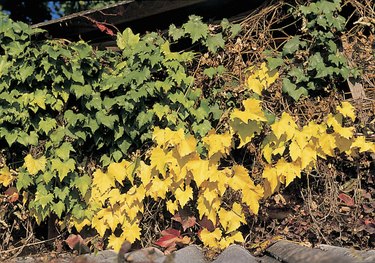Things You'll Need
Pruning shears
Garden fork
Organic compost
Bucket
Shovel
Box
Trellis
Ties
Fertilizer
Mulch

Domestic grapevines grow in many varieties through the country, with different sizes, shapes and fruits. Most domestic varieties started as wild grapes, though, with careful breeding and selection to produce different characteristics. Wild grapes still grow in the forests and fields of the nation, bearing darker foliage and smaller fruit than their domesticated cousins. Wild grapes are tart and more strongly flavored than domestic grapes, but make delicious jam, jelly and wine. If you've found a patch of wild grapes, transplant some of them to your yard for your own bright, juicy summer and fall harvests.
Step 1
Transplant the grapevines in early spring or late fall, when temperatures are cool and the grapevines are dormant. Dormancy and moist, cool weather produce the most successful transplants.
Video of the Day
Step 2
Choose and prepare a garden site for the grapevines before you transplant. Find a site with full sunshine all day, quick air circulation and good drainage. Allot 10 feet in the row for each grapevine. Prepare individual 2-foot-square plots for planting, rather than preparing the entire area. Dig the soil to a depth of 12 inches, mix it and tuck in 5 to 6 inches of organic compost. Grapevines require deep, loose and nutritious soil mixtures for success.
Step 3
Choose a number of healthy wild grapevines, or canes. Cut these canes to 2 to 3 feet in length for easier transplant and healthy new growth. Pour water over the soil around your chosen vines to make the digging easier.
Step 4
Slide the shovel into the soil 1 to 2 feet from the base of each cane to find the root balls and and lever them out of the soil. Put the grapevines and their root balls in a box for transport, along with plenty of native soil.
Step 5
Plant the grapevines in their new sites at their original planting depth, or with their roots just under the soil surface. Water each vine with 1/2 gallon of water to settle the soil around the roots, and put them on a schedule of 2 inches of water, once a week. Spread 2 inches of mulch over the surrounding soil for moisture and warmth.
Step 6
Erect a trellis to provide the grapevines training and support. Tie the main vines of the grapevines to the trellis and train the fruiting vines along the wires of the trellis.
Step 7
Fertilize the grapevines in the spring when they begin to show new growth. Scatter 10-10-10 granular fertilizer in a circle around each grapevine and mix it into the soil. Maintain at least 6 inches of space between the grapevines and the fertilizer granules. Always water the grapevines immediately after feeding.
Tip
Take cuttings of wild grapevines and root them at home for an easier transplant process.
Wild grapevines reach up to 80 feet tall in the wild. Prune them every winter to maintain controlled, compact growth and better fruit production.
Video of the Day